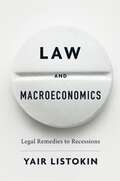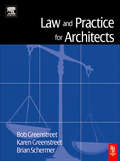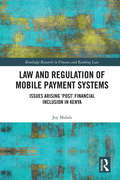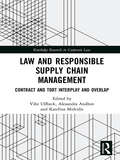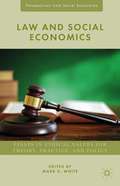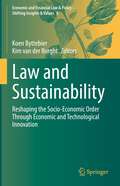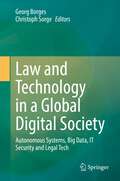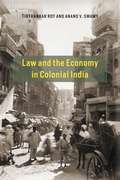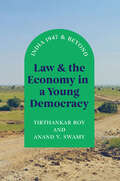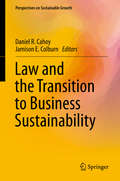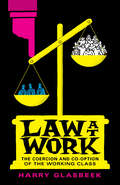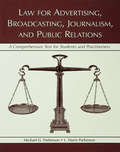- Table View
- List View
Law and Investment in China: The Legal and Business Environment after China's WTO Accession
by Xiaowen Tian Vai Io LoThe Chinese market is appealing, but the Chinese legal system is very complicated. A basic understanding of Chinese law is absolutely crucial for companies investing in this fast-growing and potentially huge market. Since China is moving toward a socialist market economy and is increasingly integrated into the world market, some aspects of China's commercial law are different from, while others are moving into line with, those of mature market economies. This book provides an introduction to the Chinese legal system, focusing on laws and regulations on foreign direct investment and highlights recent government policies and measures undertaken to intensify economics reforms so as to meet various challenges arising from China's accession to the World Trade Organization.
Law and Legal Reasoning: An Introduction
by Henry B. ReilingGives prominence to Mr. Justice Holmes' Prediction Theory of the law as a practical--and by analogy to forecasting in finance and other functional areas of business--comfortable, and familiar way for businesspeople to think about the law. Law is defined as a forecast of what the relevant facts proving the presence or absence of those concepts or principles will turn out to be. The basis for the forecast of concepts is a hierarchy of sources beginning with statutes, followed in sequence by an assessment of case precedent and considerations of social advantage.
Law and Macroeconomics: Legal Remedies to Recessions
by Yair ListokinAfter 2008, private-sector spending took a decade to recover. Yair Listokin thinks we can respond more quickly to the next meltdown by reviving and refashioning a policy approach, used in the New Deal, to harness law’s ability to function as a macroeconomic tool, stimulating or relieving demand as required under certain crisis conditions.
Law and Order Leviathan: America’s Extraordinary Regime of Policing and Punishment
by David GarlandHow American-style capitalism creates a coercive state unlike any otherHow could America, that storied land of liberty, be home to mass incarceration, police killings, and racialized criminal justice? In Law and Order Leviathan, David Garland explains how America&’s racialized political economy gives rise to this extraordinary outcome.The United States has long been an international outlier, with a powerful business class, a weak social state, and an exceptional gun culture. Garland shows how, after the 1960s, American-style capitalism disrupted poor communities and depleted social controls, giving rise to violence and social problems at levels altogether unknown in other affluent nations. Aggressive policing and punishment became the default response.Marshalling a wealth of evidence, Garland shows that America lags behind comparable nations in protections for working people. He identifies the structural sources of America&’s penal state and the community-level processes through which political economy impacts crime and policing. He argues that there is nothing paradoxical in America&’s reliance on coercive state controls; the nation&’s vaunted liberalism is largely an economic liberalism devoted to free markets and corporate power rather than to individual dignity and flourishing. Fear of violent crime and distrust of others ensure public support for this coercive Leviathan; racism enables indifference to its harms.America&’s carceral regime will remain an outlier until America&’s economy is structurally transformed. And yet, Garland argues, there is a path to reduced violence and significant penal reform even in the absence of structural change. Law and Order Leviathan sets out a powerful theory of the relation between political economy and crime control and a realistic framework for pursuing progressive change.
Law and Practice for Architects
by Robert Greenstreet Karen Greenstreet Brian SchermerProvides a framework for understanding of the legal, contractual and procedural implication of architectural practice. The book acts as a useful aide-memoire for students and practitioners based on the premise that smooth legal administration will provide the conditions under which client relations can be constructive and good design can be achieved.
Law and Practice of Crowdfunding and Peer-to-Peer Lending in Australia, China and Japan
by Pelma Rajapakse Yinxu Huang Hatsuru MoritaThe revolution in financial technology (FinTech) has created many advancements in the lending and investment space across the world. Law and Practice of Crowdfunding and Peer-to-Peer Lending in Australia, China, and Japan is a timely publication as FinTech grows up and moved into the mainstream of finance in the last decade. Financial services is a highly regulated industry as it is the lifeblood of a modern economy. Pelma Rajapakse, Hatsuru Morita, and Yinxu Huang have done very solid work blazing a new trail in what is a new industry and how to regulate it properly instead of stifling innovation. They have carried out a deep exploration and a thorough compilation of research that will bring everyone up to date on what Australia, China, and Japan are planning and doing in the field of crowdfunding and peer-to-peer lending. In addition to peer-to-peer lending, the book focuses on laws and practices related to Central Bank digital currencies, cryptocurrency, Bitcoin, and Initial Coin Offerings (ICOs) which is very meaningful and forward-looking. The authors presented their thoughts in such clarity that, even those who lack familiarity with Asia-Pacific, will see how FinTech was growing in various ways driven by different factors. For example, peer-to-peer lending in Japan is mostly for small and medium enterprises. It was popular in China but cracked down by the authorities for a few years. It provides an alternative fundraising channel for the capital market in Australia. We also see a set of regulatory approaches among jurisdictions. Some countries draft new regulations, while others amend existing laws. The mechanism of the regulatory sandbox was introduced. As we know, one size does not fit all. What kind of best practices or lessons learned can we apply to our own jurisdiction? This book covers all available answers to date. This volume speaks highly of the quality and foresight of Pelma Rajapakse and her co-authors.
Law and Practice of Debt Finance in Modern China: Cross-border Perspectives (Modern China and International Economic Law)
by Xin ZhangThis book provides updated, full-picture analysis of the laws and practices of cross-border debt finance in the PRC. It is featured by the first-handed experiences of the author’s academic research and legal practice in this field over two decades. The author discusses legal and regulatory issues, transaction structures and documentation in relation to two debt finance products: loan and bond, covering the inbound structure (Chinese debtors’ raising funds from the international market) and the outbound structure (Chinese creditors’ supplying funds to the international market). For cross-border loans, this book thoroughly illustrates the foreign debt regulatory regime in the PRC and approaches the lending by Chinese banks to support exports and overseas investments under the “Belt and Road Initiative” (BRI). For cross-border bonds, it discusses how Chinese issuers, by designing various transaction structures, enter into the international bond market, and then researches the “opening-up” of Chinese bond market to both international issuers (for issuing “Panda Bonds”) and investors (for purchasing Chinese bonds). This book is used as an authoritative source for not only students and researchers, but also bankers and legal practitioners, who are interested in the Chinese debt finance market.
Law and Practice of Liability Management
by Apostolos Ath. GkoutzinisTender offers, exchange offers and consent solicitations in connection with debt securities are important instruments of corporate restructurings, corporate rescues, recapitalisations and other types of liability management of public and private companies. Although tender offers for shares, stocks and other equity securities are covered by a vast literature on public mergers, takeovers and acquisitions, the literature on liability management transactions for debt securities is scarce. Law and Practice of Liability Management rectifies this by providing a systematic treatise of the law relating to this significant aspect of the global capital market. It guides students and professionals through the complex legal and regulatory requirements applicable to these transactions, the increasing regulatory interest by the world's leading financial regulatory authorities, and recent innovations in the structuring, legal techniques and execution of the relevant transactions in international capital markets.
Law and Regulation of Air Cargo
by Ruwantissa AbeyratneThis book explores the legal and regulatory aspects of the complex air cargo sector, discussing in detail the general principles of the carriage of air cargo; artificial intelligence and air cargo; facilitation; carriage of hazardous goods; human remains; and animals, as well as cargo security; price fixing and anti competitive conduct in air cargo operations; liability issues; the air cargo supply chain and contract of carriage. It also discusses related achievements of the International Civil Aviation Organization; the International Air Transport Association and Airports Council International. The value of goods carried by airlines represents 7.4% of the global Gross Domestic Product. While cargo carried by air accounts for less than 1% of global cargo carriage, airlines carry 35% of the value of world trade, making this industry highly valuable and efficient, and the most reliable way to transport goods throughout the world. On average, airlines transport 52 million metric tons of goods per annum, worth an equivalent of $6.8 trillion, i.e. $18.6 billion worth of goods daily.
Law and Regulation of Mobile Payment Systems: Issues arising ‘post’ financial inclusion in Kenya (Routledge Research in Finance and Banking Law)
by Joy MalalaOver the last ten years mobile payment systems have revolutionised banking in some countries in Africa. In Kenya the introduction of M-Pesa, a new financial services model, has transformed the banking and financial services industry. Giving the unbanked majority access to the financial services market it has attracted over 18 million subscribers which is remarkable given that fewer than 4 million people in Kenya have bank accounts. This book addresses the legal and regulatory issues arising out of the introduction of M-Pesa in Kenya and its drive towards financial inclusion. It considers the interaction between regulation and technological innovation with a particular focus on the regulatory tools, institutional arrangements and government decisional processes through the examination as a whole of its regulatory capacity. This is done with a view to understanding the regulatory capacity of Kenya in addressing the vulnerabilities presented by technological innovation in the financial industry for consumers after financial inclusion. It also examines the way that mobile payments have been regulated by criticising the piecemeal approach that the Central Bank of Kenya has taken in addressing the legal and regulatory issues presented by mobile payments. The book argues there are significant gaps in the regulatory regime of mobile banking in Kenya.
Law and Responsible Supply Chain Management: Contract and Tort Interplay and Overlap (Routledge Research in Corporate Law)
by Vibe Ulfbeck Alexandra Andhov Kateřina MitkidisCorporate Social Responsibility has for long been on the agenda in the business world and recently, it has also become a political agenda in the European Union. Focusing on international supply chains and their control based on studies of law in several European jurisdictions, this book aims to advance the discussion on the application and enforcement of CSR. Drawing parallels to US and Canadian law, the book explores to what extent private law tools can be used as an enforcement device and it ultimately asks if what we are witnessing is the formation of a new area of law, employing the interplay of contract and tort – a law of "production liability", as a corollary of the concept of "product liability".
Law and Social Economics
by Mark D. WhiteThis edited volume is the first collection of essays exploring the intersection of social economics and the law, providing alternatives to neoclassical law-and-economics and applying them to real-world issues. Law is a social enterprise concerned with values such as justice, dignity, and equality, as well as efficiency - which is the same way that social economists conceive of the economy itself. Social economists and legal scholars alike need to acknowledge the interrelationship between the economy and the law in a broader ethical context than enabled by mainstream law-and-economics. The ten chapters in Law and Social Economics, written by an international assortment of scholars from economics, philosophy, and law, employ a wide variety of approaches and methods to show how a more ethically nuanced approach to economics and the law can illuminate both fields and open up new avenues for studying social-economic behavior, policy, and outcomes in all their ethical and legal complexity.
Law and Sustainability: Reshaping the Socio-Economic Order Through Economic and Technological Innovation (Economic and Financial Law & Policy – Shifting Insights & Values #6)
by Koen Byttebier Kim van der BorghtThis book deals with some aspects of the future shape of the socio-economic order which would be founded on sustainability principles and the role of law therein, instead of on the prevailing capitalist economic order. The volume elaborates in particular on how innovation, a crucial aspect of free-market capitalism and its laws which constitute the current socio-economic order, could result in a more sustainable economy which, in turn, could lead to a more sustainable society. Moreover, the book analyses current developments in financial and economic law and evaluates their perks, risks and sustainability levels.The book contains no less than 11 chapters in which a variety of experts share their state-of-the-art insights regarding specific domains of socio-economic life. As such, the book deals with topics that are at present fully under debate in societies, such as student credit and the dangers it entails, cryptocurrencies and how the law tries to regulate this basically private law instrument, groups of companies under Belgian (company) law, a proposal for improving the international monetary system, and seeds and intellectual property rights, besides various other similar themes. The book forms the latest volume of the book series Economic and Financial Law & Policy – Shifting Insights & Values, and fully complies with the series’ goal of critically examining the legal methods and mechanisms that shape the global free markets and proposing alternatives to them. The book will hereby prove a valuable instrument for all researchers investigating these matters, besides policymakers and their advisers as well as all lawyers active in the field of economic law who look for a new perspective on the subject matters dealt with.
Law and Technology in a Global Digital Society: Autonomous Systems, Big Data, IT Security and Legal Tech
by Georg Borges Christoph SorgeThis book examines central aspects of the new technologies and the legal questions raised by them from both an international and an inter-disciplinary perspective. The technology revolution and the global networking of IT systems pose enormous challenges for the law. Current areas of discussion relate to autonomous systems, big data and issues surrounding legal tech. Ensuring data protection and IT security as well as the creation of a legal framework for the new technology as a whole can only be achieved through international and inter-disciplinary co-operation.The team of authors is made up of experienced, internationally renowned experts as well as young researchers and professionals who give valuable insights from numerous different jurisdictions. This book is written for jurists and those responsible for technology in public authorities and companies as well as practising lawyers and researchers.
Law and the "Sharing Economy": Regulating Online Market Platforms (Law, Technology and Media)
by Mariana Valverde Eric Tucker Michael Geist Harry Arthurs Francesco Ducci Marie-Cécile Escande-Varniol Vincent Gautrais Eran Kaplinsky Nofar Sheffi Sabrina Tremblay-HuetControversy shrouds sharing economy platforms. It stems partially from the platforms’ economic impact, which is felt most acutely in certain sectors: Uber drivers compete with taxi drivers; Airbnb hosts compete with hotels. Other consequences lie elsewhere: Uber is associated with a trend toward low-paying, precarious work, whereas Airbnb is accused of exacerbating real estate speculation and raising the cost of long-term rental housing. While governments in some jurisdictions have attempted to rein in the platforms, technology has enabled such companies to bypass conventional regulatory categories, generating accusations of “unfair competition” as well as debates about the merits of existing regulatory regimes. Indeed, the platforms blur a number of familiar distinctions, including personal versus commercial activity; infrastructure versus content; contractual autonomy versus hierarchical control. These ambiguities can stymie legal regimes that rely on these distinctions as organizing principles, including those relating to labour, competition, tax, insurance, information, the prohibition of discrimination, as well as specialized sectoral regulation. This book is organized around five themes: technologies of regulation; regulating technology; the sites of regulation (local to global); regulating markets; and regulating labour. Together, the chapters offer a rich variety of insights on the regulation of the sharing economy, both in terms of the traditional areas of law they bring to bear, and the theoretical perspectives that inform their analysis. Published in English.
Law and the Economy in Colonial India
by Tirthankar Roy Anand V. SwamySince the economic reforms of the 1990s, India's economy has grown rapidly. To sustain growth and foreign investment over the long run requires a well-developed legal infrastructure for conducting business, including cheap and reliable contract enforcement and secure property rights. But it's widely acknowledged that India's legal infrastructure is in urgent need of reform, plagued by problems, including slow enforcement of contracts and land laws that differ from state to state. How has this situation arisen, and what can boost business confidence and encourage long-run economic growth? Tirthankar Roy and Anand V. Swamy trace the beginnings of the current Indian legal system to the years of British colonial rule. They show how India inherited an elaborate legal system from the British colonial administration, which incorporated elements from both British Common Law and indigenous institutions. In the case of property law, especially as it applied to agricultural land, indigenous laws and local political expediency were more influential in law-making than concepts borrowed from European legal theory. Conversely, with commercial law, there was considerable borrowing from Europe. In all cases, the British struggled with limited capacity to enforce their laws and an insufficient knowledge of the enormous diversity and differentiation within Indian society. A disorderly body of laws, not conducive to production and trade, evolved over time. Roy and Swamy's careful analysis not only sheds new light on the development of legal institutions in India, but also offers insights for India and other emerging countries through a look at what fosters the types of institutions that are key to economic growth.
Law and the Economy in a Young Democracy: India 1947 and Beyond (Markets and Governments in Economic History)
by Tirthankar Roy Anand V. SwamyAn essential history of India's economic growth since 1947, including the legal reforms that have shaped the country in the shadow of colonial rule. Economists have long lamented how the inefficiency of India's legal system undermines the country’s economic capacity. How has this come to be? The prevailing explanation is that the postcolonial legal system is understaffed and under-resourced, making adjudication and contract enforcement slow and costly. Taking this as given, Law and the Economy in a Young Democracy examines the contents and historical antecedents of these laws, including how they have stifled economic development. Economists Roy and Swamy argue that legal evolution in independent India has been shaped by three factors: the desire to reduce inequality and poverty; the suspicion that market activity, both domestic and international, can be detrimental to these goals; and the strengthening of Indian democracy over time, giving voice to a growing fraction of society, including the poor. Weaving the story of India's heralded economic transformation with its social and political history, Roy and Swamy show how inadequate legal infrastructure has been a key impediment to the country's economic growth during the last century. A stirring and authoritative history of a nation rife with contradictions, Law and the Economy in a Young Democracy is essential reading for anyone seeking to understand India's current crossroads—and the factors that may keep its dreams unrealized.
Law and the Economy in a Young Democracy: India 1947 and Beyond (Markets and Governments in Economic History)
by Tirthankar Roy Anand V. SwamyAn essential history of India's economic growth since 1947, including the legal reforms that have shaped the country in the shadow of colonial rule. Economists have long lamented how the inefficiency of India's legal system undermines the country’s economic capacity. How has this come to be? The prevailing explanation is that the postcolonial legal system is understaffed and under-resourced, making adjudication and contract enforcement slow and costly. Taking this as given, Law and the Economy in a Young Democracy examines the contents and historical antecedents of these laws, including how they have stifled economic development. Economists Roy and Swamy argue that legal evolution in independent India has been shaped by three factors: the desire to reduce inequality and poverty; the suspicion that market activity, both domestic and international, can be detrimental to these goals; and the strengthening of Indian democracy over time, giving voice to a growing fraction of society, including the poor. Weaving the story of India's heralded economic transformation with its social and political history, Roy and Swamy show how inadequate legal infrastructure has been a key impediment to the country's economic growth during the last century. A stirring and authoritative history of a nation rife with contradictions, Law and the Economy in a Young Democracy is essential reading for anyone seeking to understand India's current crossroads—and the factors that may keep its dreams unrealized.
Law and the New Developmental State
by David M. Trubek Helena Alviar Garcia Diogo R. Coutinho Alvaro Santos David M. Trubek Helena Alviar Garcia Diogo R. CoutinhoThis book explores the emergence of a new developmental state in Latin America and its significance for law and development theory. In Brazil since 2000, emerging forms of state activism, including a new industrial policy and a robust social policy, differ from both classic developmental state and neoliberal approaches. They favor a strong state and a strong market, employ public-private partnerships, seek to reduce inequality, and embrace the global economy. Case studies of state activism and law in Brazil show new roles emerging for legal institutions. They describe how the national development bank uses law in innovation promotion, trade law strengthens new developmental policies in export promotion and public health, and social law frames innovative poverty-relief programs that reduce inequality and stimulate demand. Contrasting Brazilian experience with Colombia and Mexico, the book underscores the unique features of Brazil's trajectory and the importance of this experience for understanding the role of law in development today.
Law and the Transition to Business Sustainability
by Daniel R. Cahoy Jamison E. ColburnThis book expands on law-related research by examining the legal aspects of sustainability with a focus on the impact on business strategies. It recognizes that firms must adopt an integrated approach to law and sustainability, considering multiple disciplines and goals, and serve as a forum for bringing together scholarship from fields such as environmental law, energy, government regulation and intellectual property. Firms increasingly have an interest in transitioning to sustainable business practices that take into consideration the fact that global resources are finite and will be increasingly scarce. They acknowledge that current actions have social, economic and environmental consequences and employ options to ensure that future generations have the same options and benefits. Examples of sustainable practices increasingly employed by firms include the institutionalization of "whole life-cycle" analysis in marketing and product design, utilization of sustainable inputs and energy sources, tracking and reporting sustainability performance, attempting the valuation of future generation prosperity and happiness as a discounting mechanism, and integrating sustainability into firm culture and management goals. It is clear that law and regulation have an extremely important role to play in the transition to more sustainable business practices. Broadly stated, law can provide structure for firms responding to forces that pull transition by enabling sustainability leadership and competitive advantage through funding models, intellectual property rights and collaboration means. Additionally, law can work to push transition by compelling firms to act through regulatory structures, accounting and governance mechanisms.
Law and the Wealth of Nations: Finance, Prosperity, and Democracy
by Tamara LothianEconomic stagnation, financial crisis, and increasing inequality have provoked worldwide debate about the reshaping of the market economy. But few are willing to risk a reorientation of dominant ideas and a reform of entrenched structures. Right-wing populism has stepped into the void created by a failure to imagine structural alternatives. Tamara Lothian offers a deeper view showing the path to the reconstruction of the economy in the service of both growth and inclusion. She probes the institutional innovations that would reignite economic growth by democratizing the market. Progressives have traditionally focused only on the demand side of the economy, abandoning the supply side to conservatives. Law and the Wealth of Nations offers a progressive approach to the supply side of the economy and proposes innovation in our fundamental economic arrangements.Lothian begins by exploring how finance can serve broad-based economic growth rather than serving only itself. She goes on to show how the reform of finance can lead into the democratization of the economy. How, she asks, can we ensure that the most advanced, knowledge-intensive practices of production spread throughout the economy rather than remaining in the hands of the entrepreneurial and technological elite? How can we anchor greater economic equality and empowerment in the way we organize the economy rather than just trying to diminish inequalities after the fact by progressive taxation and entitlements? How can we revise legal thought and economic theory to develop the intellectual equipment that these tasks require? Law and the Wealth of Nations will appeal to all who are searching for ways to think practically about change in our economic and political institutions.
Law at Work: The Coercion and Co-option of the Working Class
by Harry GlasbeekIn a series of illuminating essays, the renowned Harry Glasbeek unpacks how law has been used to ensure that workers' aspirations are kept in check. Law at Work uncovers how the legal system, through its structures and mechanisms, legitimizes and reinforces the exploitation of workers. Using historic and contemporary examples, Glasbeek illustrates how conscious manipulations of law are part and parcel of how law protects capitalists at the expense of workers. He proves how the very laws designed to safeguard rights and freedoms often act as invisible shackles, compelling readers to reflect on their own struggles as they navigate a world where the legal system fails to serve their interests. These manipulations are made to look innocent because the underlying structures and ideology which give rise to specific rules are not challenged or challengeable. This thought-provoking book is an indispensable resource for those seeking to understand the hidden dynamics of worker oppression, empowering readers to question prevailing narratives and envision a future where the law truly serves the interests of all.
Law for Advertising, Broadcasting, Journalism, and Public Relations: A Comprehensive Text For Students And Practitioners (Routledge Communication Series)
by Michael G. Parkinson L. Marie ParkinsonThis exceptional new text offers an up-to-date and integrated approach to communication law. Written by two practicing attorneys with extensive experience teaching the communication law course, Law for Advertising, Broadcasting, Journalism, and Public Relations covers the areas of communication law essential and most relevant for readers throughout the communication curriculum. Its integrated approach will serve students and practitioners in advertising and public relations as well as those in journalism and electronic media.Providing background to help readers understand legal concepts, this comprehensive communication law text includes an introduction to the legal system; covers legal procedures, structures, and jurisdictions; discusses the First Amendment and electronic media regulations; and considers issues of access. Additional material includes: *intellectual property law; *employment and agency law, with explanations of how these laws create obligations for mass communication professionals and their employees; *commercial communication laws; and *special laws and regulations that impact reporters, public relations practitioners, and advertisers who deal with stock sales.Special features of this text include:*Magic Words and Phrases--defining legal terms;*Cases--illustrating key points in each chapter;*Practice Notes--highlighting points of particular interest to professional media practices;*Instructions on finding and briefing cases, with a sample brief; and*Examples of legal documents and jury instructions.This text is intended as an introduction to communication law for students and practitioners in mass communication, journalism, advertising, broadcasting, telecommunications, and public relations.
Law for Architects: What You Need to Know
by Robert F. Herrmann Menaker Herrmann LlpAn essential reference for practitioners, emphasizing how legal concepts affect the process of bringing architectural vision to reality. Law for Architects: What You Need to Know guides design professionals through the daunting landscape where design and construction meet the legal system. It provides an introduction--written in clear, reader-friendly language--to issues that arise at every stage in the practice of architecture. For architects starting or building their own practice: Why do I need a written agreement with my clients? Why do I need insurance? How do I organize my firm? For seasoned architects considering retirement: How do I transfer ownership in my company? How can I benefit from the good will I helped to build? For students who want to learn more about the practicalities of starting out: Why is it important to have a license? Isn't it enough to have a degree in architecture? What are my rights as an employee? It also addresses the perennial questions that concern architects: How do I protect myself from being sued? How do I protect my intellectual property rights in my work? and much more. Law for Architects identifies the legal issues that lurk in every corner of your design practice and helps you figure out what questions you need to ask.
Law for Business
by Eric L. Richards A. James Barnes Terry Morehead DworkinBusiness Law 10/e has provided students with a comprehensive, yet concise treatment of the legal issues of fundamental importance to business students and the business profession. The cases, which have always been a strong feature, are edited and re-written by the authors, who divide the material into three categories: facts, issues, decisions. The authors, Barnes, Dworkin, and Richards, choose cases that are appropriate to explain precedent and history as well as include “hot topic” cases that relate to current events. In addition to case applications, the authors use such techniques as content summaries to apply concepts to practice. Effective managers and employees must develop knowledge of both law and business because people involved in business also are involved in, and greatly affected by, the laws concerning business.


